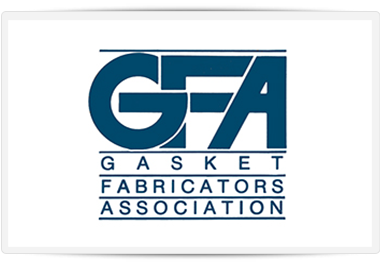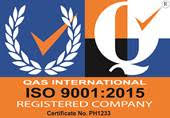A die cut rubber gasket is an essential component of many products. Gaskets seal systems, absorb vibration, and reduce sound. Whether you need rubber gaskets for planes, trains, automobiles, or household blenders, the rubber gasket materials you select depends on the function and the operating environment.
Pure Rubber Gum
Natural polyisoprene is the primary chemical constituent of natural rubber. It begins as the sap from the rubber tree, Hevea brasiliensis, and is then processed and vulcanized. Because the sap varies from plant to plant, there are slight variations in the finished product.
It is an inexpensive elastomer with good fatigue resistance. However, petroleum-based liquids contain a variety of long-chain hydrocarbons that damage natural rubber. That makes it a no-go for automotive fluids, degreasers, and petroleum hydraulic fluids. However, it is well suited for use with alcohols, organic acids, and ketones.
The double bonds in the polymer backbone are prone to oxidative degradation so their lifespan is reduced by oxygen and ozone. That means this isn’t gasket material for outdoor use.
The working temperature range for natural rubber gaskets is approximately -40°F to 140°F. It remains pliable and flexible, even at the lower limits of the temperature range.
In the right environment, this is a great choice for cushioning impacts, resisting abrasion, and damping vibration.
Synthetic Rubber
Chemists refer to it as synthetic cis-1,4-polyisoprene. But you can call it synthetic rubber or synthetic polyisoprene if you want to get fancy.
It is the man-made equivalent of natural rubber. Since it is completely man-made, you eliminate the material inconsistencies caused by variations in the base sap. The result is a product with the positive attributes of natural rubber with the added bonus of consistency. Of course, you’ll pay a slightly higher price for that consistency. Synthetic rubber costs just a tad more than natural rubber.
It is slightly less viscous during processing which results in a material that weathers a bit better than natural rubber. But it still doesn’t stand up to oxygen and ozone so outdoor use in sunny areas isn’t a good idea.
Like natural rubber, it has that long chain of hydrocarbons that don’t work and play well with petroleum-based products.
Styrene-Butadiene Rubber (SBR)
Styrene-Butadiene Rubber (also called red rubber) was developed during World War I as a substitute for natural rubber. Getting rubber sap out of Asia in wartime conditions was a challenge, so scientists had to find an alternative. It was one of those “necessity is the Mother of invention” operations.
As the name suggests, it is derived from styrene and butadiene. Like synthetic rubber, it is highly consistent from lot to lot. And it is priced in the same neighborhood as synthetic rubber.
The material is soft and has good compression recovery. That makes it well suited for applications where flange surfaces may be uneven.
Like natural and synthetic rubber, it maintains flexibility in cold weather. It also has high impact strength, abrasion resistance, and heat resistance.
On the downside, it shouldn’t be used with petrochemical-based solutions because of swelling and material degradation. However, on the upside, it is perfect for water and steam applications.
It has a greater temperature range than natural or synthetic rubber. Red rubber is well-suited for temperatures between 170° F and -30° F.
Don’t use it in applications with oxygen or ozone.
Ethylene Propylene
Ethylene Propylene Rubber (EPR) is a copolymer of ethylene and propylene. Unlike the other rubbers described so far, EPR can stand up to heat, oxygen, ozone, and even the weather. It provides excellent electrical insulation and operates in a wide range of temperatures.
It resists phosphate-ester-based hydraulic fluids, silicone oils, silicone greases, as well as glycol- and silicon-based based brake fluids. Oil swell is minimal. That makes it a material well-suited for many automotive gasket applications. This elastomer also has good abrasion and tear resistance.
Because it is oxygen and ozone resistant – it stands up to outdoor environments where natural and synthetic rubber falls short.
The cost is similar to synthetic rubber and red rubber.
Neoprene rubber
Neoprene is the trademarked name of Chloroprene made by DuPont. To the layperson, neoprene is the stuff of wetsuits. That’s because of its tremendous insulating properties. But neoprene is so much more than an insulator.
Neoprene is waterproof and corrosion resistant. It stands up to chemicals such as chemicals including solvents, oils, and petroleum-based fuels.
As a gasket material, it works well for sealing electrical units to keep dust and moisture out while providing resistance to heat, flame, and static electricity.
It remains flexible at temperatures as low as -40 °F and as high as +248 °F.
Neoprene costs more than SBR or EPR rubber.
Ethylene propylene diene monomer (EPDM)
Ethylene propylene diene monomer is chemically like EPR. It has ethylene and propylene with a third component called a diene. This diene creates double bonds in the main polymer chain that provide cross-linking sites for vulcanization.
Like EPR, EPDM stands up to heat, oxygen, and ozone. EPDM gaskets are widely used for facades and glazing. In the automotive industry, EPDM is used for O-rings and other gaskets. In the appliance industry, EPDM gaskets can be found in low-pressure boilers and walk-in cooler door gaskets.
It can withstand temperatures of -40°F to +225°F. Some EPDM is FDA-approved for use around food and food preparation. Since it provides high electrical resistance, it is well-suited for electrical applications.
Need Help Selecting Rubber Gasket Materials?
Selecting the right rubber gasket materials for your application can be confusing. It’s good to know that the professionals at Frank Lowe not only know die-cutting gaskets but also know the properties of all available rubber gasket materials.
If you need help selecting your gasket material, just ask Frank Lowe. We have access to a wide range of rubber gasket materials and don’t lock you into just a few options.
Tell us your application and we’ll help you explore your options and pursue the best possibilities. We’ll create your gaskets to your specifications and then become a trusted link in your supply chain.
Talk to Frank Lowe today.






